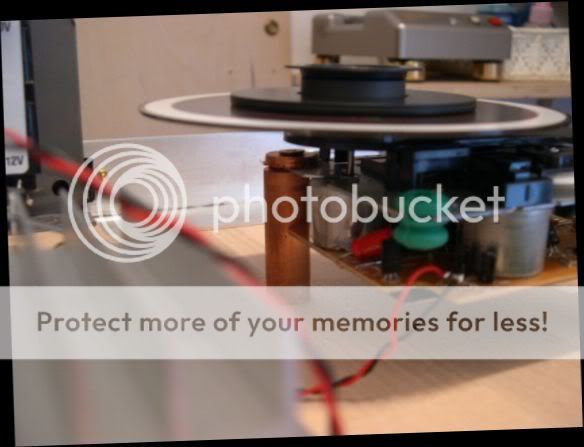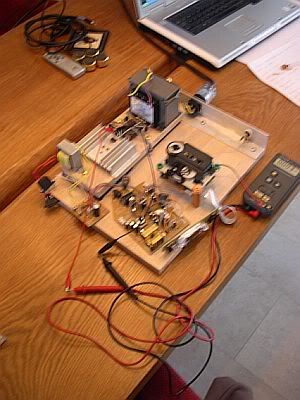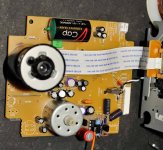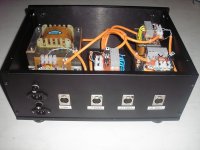Ok, as promised, results of the shigaclone vs Theta Data III transport.
The Shig is standard except for:
1. Removed choke, C916 and C952 and bypass caps
2. C916 replaced by a OSCON 47uF, 25V cap
3. 300/100 on digital output to 75R BNC connector
4. LM317 based 8V supply with around 2200uF pre and post regulator filtration
5. It is "naked" and sits on a bit of bubble wrap at the moment. No fancy mech isolation etc.
The Theta DATA III is a highly regarded "audiophile" reference that has:
1. 4 seperate transformers
2. AES/EBU reclocked output using a separate reference low noise clock (Guido Tent) and power supply (ALW)
The transports were played into the following setup:
Apogee mini-dac running off a 12V battery, which is a well regarded DAC based on AD1955 chip
Lightspeed passive pre-amp, which is the most transparent I've ever heard
KRELL 80B amps, one per channel run in vertical bi-amped mode (modded to lower noise floor etc)
Apogee Scintilla speakers (the 1 ohm version...)
Cables are wide-eye on the digital, van den hull on the dac/amps, all balanced. The Shig's output was single ended via BNC.
The result:
Highs: The theta has better resolution and separation here. It's almost like the highs are in a separate space. The Shig present's high's with less separaton
Mids: Cannot really discern differences, except that the Shig sounds "thicker"/"rounder". I actually prefer the Shig as it conveys more presence
Bass: No discernable difference!
Soundstaging: A bit more presence/forwardness on the Theta, but it's minor
Considering the difference in cost and complexity of build etc, this is a truly remarkable result!
If I can improve the Shig's highs, I'll sell the Theta!!
Peter and everyone else-thanks for sharing, you guys rock!
Best
Ryan
The Shig is standard except for:
1. Removed choke, C916 and C952 and bypass caps
2. C916 replaced by a OSCON 47uF, 25V cap
3. 300/100 on digital output to 75R BNC connector
4. LM317 based 8V supply with around 2200uF pre and post regulator filtration
5. It is "naked" and sits on a bit of bubble wrap at the moment. No fancy mech isolation etc.
The Theta DATA III is a highly regarded "audiophile" reference that has:
1. 4 seperate transformers
2. AES/EBU reclocked output using a separate reference low noise clock (Guido Tent) and power supply (ALW)
The transports were played into the following setup:
Apogee mini-dac running off a 12V battery, which is a well regarded DAC based on AD1955 chip
Lightspeed passive pre-amp, which is the most transparent I've ever heard
KRELL 80B amps, one per channel run in vertical bi-amped mode (modded to lower noise floor etc)
Apogee Scintilla speakers (the 1 ohm version...)
Cables are wide-eye on the digital, van den hull on the dac/amps, all balanced. The Shig's output was single ended via BNC.
The result:
Highs: The theta has better resolution and separation here. It's almost like the highs are in a separate space. The Shig present's high's with less separaton
Mids: Cannot really discern differences, except that the Shig sounds "thicker"/"rounder". I actually prefer the Shig as it conveys more presence
Bass: No discernable difference!
Soundstaging: A bit more presence/forwardness on the Theta, but it's minor
Considering the difference in cost and complexity of build etc, this is a truly remarkable result!
If I can improve the Shig's highs, I'll sell the Theta!!
Peter and everyone else-thanks for sharing, you guys rock!
Best
Ryan
Has anyone here tried the RF attenuators I mentioned back a few pages back?
See here (post 4111): click here
They really do make quite a difference, I would suggest to anyone to get a few of them at different values. Dr. H, they would be good at cleaning up the highs (and bass)
Fran
See here (post 4111): click here
They really do make quite a difference, I would suggest to anyone to get a few of them at different values. Dr. H, they would be good at cleaning up the highs (and bass)
Fran
I'll be very interested to hear what people's experiences are using those RF attenuators on the SPDIF line. It's on my list of things to do, and I also have a SuperTeddyReg on order - curious what effect fitting this part in place of the 2x1000uF & 7808 combo will have. His reg is very highly thought of on the Pink Fish Media forums:
Teddy Pardo home of TeddyCap TeddyXPS power supply for Naim Audio replaces HiCap and XPS
SuperTeddyReg information is found by clicking in the DIY section on the left of the screen.
Also looking forward to receiving my ebony puck this week (MANY thanks Fran!). Something tells me that without the magnet there the laser will have an easier job of tracking the disc (as the focussing coils are not having to 'fight' the extra influence of the magnetic puck), and draw slightly less current which may well explain the slight improvements in sound people have experienced here.
I think I need to look at changing my SPDIF output resistors too. The sound from my Shiga just isn't as fluid and analogue-like as my original breadboarded version. I've used Takman carbon films at the SPDIF output. However from using them again in another project recently (a B1 buffer) they sounded very 'mushy' to my ears. Not sure how that would manefest itself on the digital output however, as in the B1 they were used in the signal path. The only other differences between my Shiga and Peter Daniel's recommended version is I'm using Rubycon ZLs for the 2 x 1000uF caps, but I don't think this dissatisfaction is due to those as I've used them many times in other projects before. The only other thing I can think of is the 47uF Black Gate N (used for C916) is doing its weird burn-in thing and will suddenly come on song after a bit more use. Wouldn't have thought the famous Black Gate burn-in would be so obvious when used in the PSU section though? The chassis used for my Shiga is made by Peter Daniel, so I think I can at least rule that out
- John
Teddy Pardo home of TeddyCap TeddyXPS power supply for Naim Audio replaces HiCap and XPS
SuperTeddyReg information is found by clicking in the DIY section on the left of the screen.
Also looking forward to receiving my ebony puck this week (MANY thanks Fran!). Something tells me that without the magnet there the laser will have an easier job of tracking the disc (as the focussing coils are not having to 'fight' the extra influence of the magnetic puck), and draw slightly less current which may well explain the slight improvements in sound people have experienced here.
I think I need to look at changing my SPDIF output resistors too. The sound from my Shiga just isn't as fluid and analogue-like as my original breadboarded version. I've used Takman carbon films at the SPDIF output. However from using them again in another project recently (a B1 buffer) they sounded very 'mushy' to my ears. Not sure how that would manefest itself on the digital output however, as in the B1 they were used in the signal path. The only other differences between my Shiga and Peter Daniel's recommended version is I'm using Rubycon ZLs for the 2 x 1000uF caps, but I don't think this dissatisfaction is due to those as I've used them many times in other projects before. The only other thing I can think of is the 47uF Black Gate N (used for C916) is doing its weird burn-in thing and will suddenly come on song after a bit more use. Wouldn't have thought the famous Black Gate burn-in would be so obvious when used in the PSU section though? The chassis used for my Shiga is made by Peter Daniel, so I think I can at least rule that out
- John
Last edited:
Ok, as promised, results of the shigaclone vs Theta Data III transport.
The Shig is standard except for:
1. Removed choke, C916 and C952 and bypass caps
2. C916 replaced by a OSCON 47uF, 25V cap
3. 300/100 on digital output to 75R BNC connector
4. LM317 based 8V supply with around 2200uF pre and post regulator filtration
5. It is "naked" and sits on a bit of bubble wrap at the moment. No fancy mech isolation etc.
Best
Ryan
Hi Dr. H
what is brand of your capacitor supply ?
I think they're Panasonic or Rubycon. Will check.
1. Has anyone tried RC snubbers on the rectifying diodes?
2. Any benefit in removing the ferrite core on the stock power supply?
first time when i used 2 pcs BG Std after and before rectrifier the sound was
too high
after i change to BGF & BG Std, theres a lot of different there
This is my setup for the Shigaclone,
With the okapi modifications plus ALWSR 5v Regulator for the Shigaclone Board and a ALWSR + 8V Regulator for the Trichord clock 4
There is a lot more depth in the music and a better placement than with the "standard" version as I listen to now.
Please note, for the Shigaclone board with the ALWSR is also a 1000uf BG FK and after the ALWSR a 1000uF BG STD
For the Trichord Clock 4, 1000uF BG FK than the LM7812 then 1000uF BG STD and then the ALWSR 8 volts that connected to the Trichord Clock 4.
Rudy
With the okapi modifications plus ALWSR 5v Regulator for the Shigaclone Board and a ALWSR + 8V Regulator for the Trichord clock 4
There is a lot more depth in the music and a better placement than with the "standard" version as I listen to now.
Please note, for the Shigaclone board with the ALWSR is also a 1000uf BG FK and after the ALWSR a 1000uF BG STD
For the Trichord Clock 4, 1000uF BG FK than the LM7812 then 1000uF BG STD and then the ALWSR 8 volts that connected to the Trichord Clock 4.
Rudy
Attachments
Last edited:
Today I ordered the Trichord 4 clock and the Trichord Never Connected Power Supply (internal mounting)....
I am also in the process of ordering 2 AWLSR super regs 5 and 8 volts but as you might know when you order in England....it takes a completely different route and manner compared to the rest of the universe....
I am also in the process of ordering 2 AWLSR super regs 5 and 8 volts but as you might know when you order in England....it takes a completely different route and manner compared to the rest of the universe....

An externally hosted image should be here but it was not working when we last tested it.
An externally hosted image should be here but it was not working when we last tested it.
So these are the attenuators:
So, the shiga as standard puts out a high level SPDIF signal - well in excess of the normal consumer level. Now, the SPDIF is not DC, but because its fast, your DMM will read it as DC. I reckon this makes taking a DC measurement a reasonable way of measuring the amplitude of the SPDIF signal. I know it might not be completely accurate, but its better than guesswork.
So, I took some measurements on the shiga I just built. Before the output resistors, I get 2.1V and after the resistors, I get 0.49V - very close to the consumer spec of 0.5V. On my other Shiga, which has the reclocked output, the level is very similar.
So then I added in an attenuator and this knocked the signal down even more, to about 0.15V. This sounded a little better but I got a little white noise at the start of every track. The level is too low for the DAC to hold lock. So I decided to disconnect the resistor network (300/91 pair) and just use the attenuators to drop the level.
Some testing of different attenuation levels ensued and I ended up with a level of around 0.25V....... but heres the thing... the sound quality jumped quite a bit.
I also did some testing on my other shiga with the reclock circuit. This starts off with the same level after the reclocking - 2.2V but it takes 2 attenuators in series (25dB) to get the signal down to ~0.25V. The non-reclocked one only took 1 attenuator (either 10 or a 15dB, I'll check again later). I'm thinking that the reclocking buffers the signal, so it takes more attenuation?
So my recommendation is that you try this out. Disconnect the 300/100 from each other, you can leave them in place if you want, but take the spdif from before the resistors and use these attenuators to take down the signal to <.5V. The attenuators cost about $15 each, and I'd say get 6dB, 10dB and 15dB ones so you have a number of values to check out. FWIW, I've tried these on a number of sources and they have always brought about an improvement. No, I am not connected with minicircuits!! If I was I'd be rich I tells ya! and be having "my man" to do my work for me!
Dr. H has some ordered, so maybe wait until he has tried them out. Minicircuits are in the UK and USA, and seemed to be fine to deal with, although I did have to sign an end-user agreement to say I wasn;t going to build WMDs with the attenuators.
Fran
Fran
An externally hosted image should be here but it was not working when we last tested it.
So, the shiga as standard puts out a high level SPDIF signal - well in excess of the normal consumer level. Now, the SPDIF is not DC, but because its fast, your DMM will read it as DC. I reckon this makes taking a DC measurement a reasonable way of measuring the amplitude of the SPDIF signal. I know it might not be completely accurate, but its better than guesswork.
So, I took some measurements on the shiga I just built. Before the output resistors, I get 2.1V and after the resistors, I get 0.49V - very close to the consumer spec of 0.5V. On my other Shiga, which has the reclocked output, the level is very similar.
So then I added in an attenuator and this knocked the signal down even more, to about 0.15V. This sounded a little better but I got a little white noise at the start of every track. The level is too low for the DAC to hold lock. So I decided to disconnect the resistor network (300/91 pair) and just use the attenuators to drop the level.
Some testing of different attenuation levels ensued and I ended up with a level of around 0.25V....... but heres the thing... the sound quality jumped quite a bit.
I also did some testing on my other shiga with the reclock circuit. This starts off with the same level after the reclocking - 2.2V but it takes 2 attenuators in series (25dB) to get the signal down to ~0.25V. The non-reclocked one only took 1 attenuator (either 10 or a 15dB, I'll check again later). I'm thinking that the reclocking buffers the signal, so it takes more attenuation?
So my recommendation is that you try this out. Disconnect the 300/100 from each other, you can leave them in place if you want, but take the spdif from before the resistors and use these attenuators to take down the signal to <.5V. The attenuators cost about $15 each, and I'd say get 6dB, 10dB and 15dB ones so you have a number of values to check out. FWIW, I've tried these on a number of sources and they have always brought about an improvement. No, I am not connected with minicircuits!! If I was I'd be rich I tells ya! and be having "my man" to do my work for me!
Dr. H has some ordered, so maybe wait until he has tried them out. Minicircuits are in the UK and USA, and seemed to be fine to deal with, although I did have to sign an end-user agreement to say I wasn;t going to build WMDs with the attenuators.
Fran
Fran
The 47/50 Black Gates should sound very good right from the start, the burn-in changes their sound only slightly. At least that was my experience with all the caps I tested (including numerous other Black Gates) - the core of their sound was there immediately, and with time only subtly developed, or "bloomed".I think I need to look at changing my SPDIF output resistors too. The sound from my Shiga just isn't as fluid and analogue-like as my original breadboarded version. I've used Takman carbon films at the SPDIF output. However from using them again in another project recently (a B1 buffer) they sounded very 'mushy' to my ears. Not sure how that would manefest itself on the digital output however, as in the B1 they were used in the signal path. The only other differences between my Shiga and Peter Daniel's recommended version is I'm using Rubycon ZLs for the 2 x 1000uF caps, but I don't think this dissatisfaction is due to those as I've used them many times in other projects before. The only other thing I can think of is the 47uF Black Gate N (used for C916) is doing its weird burn-in thing and will suddenly come on song after a bit more use. Wouldn't have thought the famous Black Gate burn-in would be so obvious when used in the PSU section though? The chassis used for my Shiga is made by Peter Daniel, so I think I can at least rule that out
- John
So if there's something obviously wrong with the sound of your CD, no amount of burn-in will iron it out...
The 47/50 Black Gates should sound very good right from the start, the burn-in changes their sound only slightly. At least that was my experience with all the caps I tested (including numerous other Black Gates) - the core of their sound was there immediately, and with time only subtly developed, or "bloomed".
So if there's something obviously wrong with the sound of your CD, no amount of burn-in will iron it out...
Today I removed C916 and C952.
I replaced the C916 standard for a 33 uF/16V BlackGate (although it is as red as a Ferrari).
It is immediately "on song" so no complaints here......
I took it out of my personal collection...am I not a nice guy for my audiofriend

The 47/50 Black Gates should sound very good right from the start, the burn-in changes their sound only slightly. At least that was my experience with all the caps I tested (including numerous other Black Gates) - the core of their sound was there immediately, and with time only subtly developed, or "bloomed".
So if there's something obviously wrong with the sound of your CD, no amount of burn-in will iron it out...
I think I've narrowed it down to the digital interconnect actually - whew! On one end is a soldered phono plug, on the other is one of those 'twist on' BNC plugs. It's always touch and go how good the actual connection is between the interconnect core and the tip of the BNC plug with this type of connection. Using a BNC to phono socket converter on my DAC, and using another interconnect the sound has improved. So I'm going to desolder the BNC from my DAC and install a phono socket instead. Then I can use a different digital interconnect without any adapters.
Last edited:
I think I've narrowed it down to the digital interconnect actually - whew! On one end is a soldered phono plug, on the other is one of those 'twist on' BNC plugs. It's always touch and go how good the actual connection is between the interconnect core and the tip of the BNC plug with this type of connection. Using a BNC to phono socket converter on my DAC, and using another interconnect the sound has improved. So I'm going to desolder the BNC from my DAC and install a phono socket instead. Then I can use a different digital interconnect without any adapters.
Sounding SO much better now and showing its true potential at last. I am very relieved!
Soldered connections for me on digital cables all the way now
The culprit was this little fellow: Twiston BNC Plugs : BNC Connectors : Maplin
Convenient, but not suitable for high quality digital audio transmission in my humble opinion.
- John
- Home
- Source & Line
- Digital Source
- Finally, an affordable CD Transport: the Shigaclone story
 ....
....


